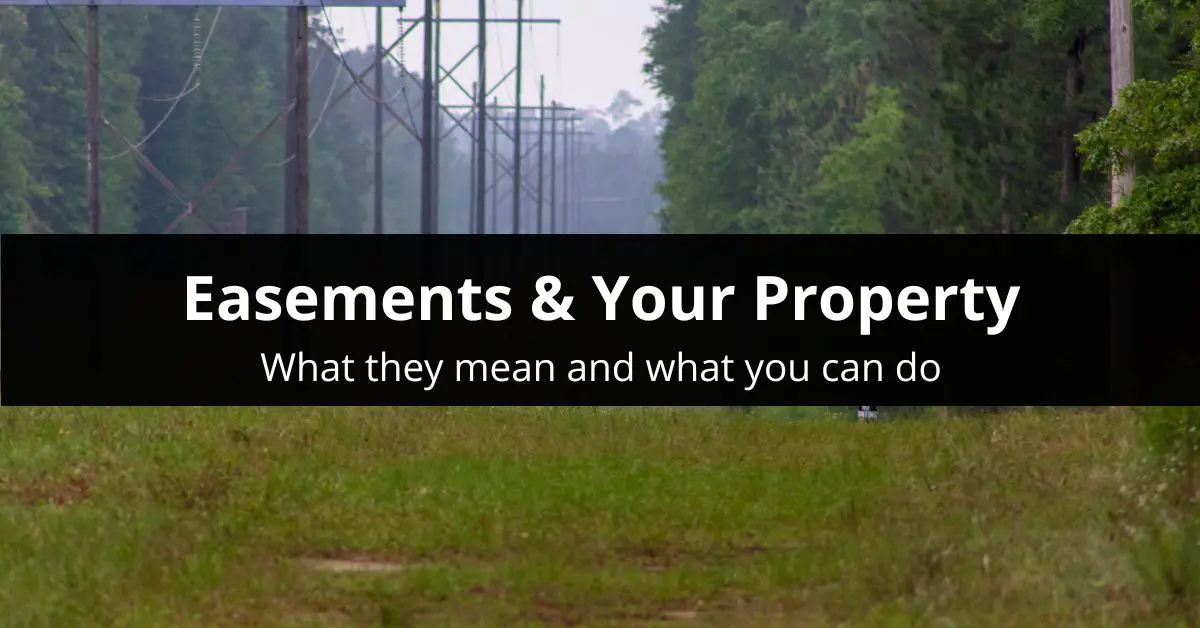When you buy a property, you expect it to be yours, and yours alone. But that isn’t always the case. Sometimes you could find there is an easement on your property, and easements are usually discovered during a title search.
If you found your property has an easement, it isn’t a big problem. They’re more common than you may think, and are normally easy to resolve.
Easements in real estate are when another entity like a neighbor, utility company, or government agency gains the right to access your property without needing your permission. In some cases a real estate easement allows the other party to use your property in a way you don’t agree with, but in most cases they aren’t a bad thing. And almost all properties have one easement on them.
For example, utility companies need to monitor the amount of service you use and to make sure their equipment is working. That is why they’ll have an easement. It is harmless and can be beneficial to you.
At the same time a real estate easement that could be burdensome is an affirmative easement which prevents you from blocking access to your property, or a negative easement that prevents you from developing your property in very specific ways. And there are multiple types of easements.
Types Of Easements
Easements are not tricky, but they can sometimes be confusing when they overlap. Here’s the different types of easements, what they mean, have in common and how they are different.
Affirmative Easements
An affirmative easement gives an easement holder the right to do something while also requiring that the property owner also do something like allowing a non-owner access to a piece of property. Most easements fall into this category.
Some examples of affirmative easements are giving permission to fish or hunt on a property, allowing a person to cross your property, and the right to use water from an adjacent property.
Negative Easements
Negative easements are the opposite of affirmative easements and prohibit a property owner from doing something like adding a second story to their house or blocking a mountain view. In most states, negative easements can’t be implied and are treated like restrictive covenants since they are recorded in a property’s deed.
Examples of negative easements are:
- Requiring an owner to maintain a fence or driveway for the benefit of a neighbor
- Restricting certain kinds of structures
- Not allowing an owner to build within 50 ft of the edge of your property
- Prohibiting land development
If you don’t comply with a negative easement, it can result in a lawsuit where you can be liable for damages.
Easement Appurtenant
An easement appurtenant grants the right to use a neighboring property for a specific and limited purpose.
Common reasons for an easement appurtenant are:
- Allowing landlocked landowners access to the nearest road
- Running power or gas lines
- Installing (and maintaining) sewer systems
- Building roads
Easement appurtenants are tied to the land and are recorded as part of the deed. If an owner sells, the new owner has to allow the easement holder to continue to use the land.
Depending on the situation and your state laws, there are a few ways to create an easement appurtenant: express easement, implied easement, easement of necessity, and prescriptive easement.
Express Easements
Express easements are an easement that is written down like a deed or will and the specific rights given depend on the terms of the formal agreement.
For example, if a person wants to regularly walk through a neighbor’s property to get to a public park, they would need to ask for an easement appurtenant. If the neighbor agrees, an easement deed would be written down and signed. The easement would then become part of the neighbor’s property.
Implied Easements
Unlike express easements, implied easements are not written down, because the need for this easement is apparent. Usually implied easements happen when a large piece of land is divided into smaller lots.
While each state has its own rules, there are two common requirements:
- The easement is required to enjoy the property.
- Previous owners had the usage rights you’d like (prior use).
For example, a neighbor sells you 10 acres of a 50-acre lot and your “new” land has a pond on it. However, before splitting the property up, your neighbor built a path and used it to get to the pond. Now, after splitting the property, part of that path runs through their land. You would have an implied easement for the path your neighbor built, because you need it to enjoy your property to the fullest. It also matches the prior use of the path.
Once an easement holder has an implied easement, the property owner usually can’t change the terms of the easement.
Easements By Necessity
An easement by necessity is a court-created easement (similar to implied easements) that allows you to use a piece of property to get to another area of the land. This right is tied to the land and not the property owner. There is one key difference between implied easements and easement by necessity; easements by necessity are a necessity to access your land.
For example, in the situation listed under implied easements, you wouldn’t get an easement of necessity, since you can build a road to gain access to the pond. However, if this lot is landlocked, your neighbor would have to grant an easement of necessity, so you can get to your property.
An easement by necessity can be terminated when the necessity no longer exists like a new road is built to create access to the previously landlocked parcel.
Prescriptive Easements
A prescriptive easement, also known as an “easement by prescription”, is created when a non-owner continually and openly uses a portion of a property they don’t own for a specific reason. Usually this can be a shortcut or a way to access a public place like a beach.
Prescriptive easements are created in a process similar to adverse possession:
- A non-owner uses a property blatantly and without sneaking around.
- The non-owner uses the property as though they were an owner (for example, mowing the lawn).
- The use of the property is continuous for the statutory period of the state in which the property is in (20 years in Wisconsin and 15 years in Minnesota).
- The non-owner does not have the owner’s permission to use the property.
Like implied easements, prescriptive easements are usually not documented.
You can also sell a prescriptive easement. If you own a lakefront home, you can sell your neighbors the right to use your property for the specific purpose of dock access. The easement would be recorded on the deed and will turn up on a title search.
Prescriptive easements are permanent and last even if the owner sells the property. This is why it is important to pay attention to the results of a title search report whether you are selling your house or buying a house. You want to know how to prepare if a buyer asks, or what to ask if you’re purchasing a property with an easement on it.
Private Easements
Private easements are property rights that can be created, sold, or given by the owner to another party. The main difference between private and public easements is a private easement allows your neighbor to take a shortcut across your property where a public easement allows anyone from the public to walk through your yard.
This right is tied to the land and should be listed on the title.
Public Easements
If an easement is a public easement, a landowner allows the public to access a defined area of their land for the reasons stated in the easement like right-of-way access to a main road or a public beach that is inaccessible otherwise.
Blocking access to a public easement can result in legal action, and once a public easement is granted, it becomes a part of the land and title.
Easements In Gross
An easement in gross, also known as a “personal easement”, is a type of easement that gives a non-owner the right to use land that they do not own, but it does not become part of the title nor transfers from owner to owner. Easements in gross are attached to the owner and not to the property.
Sometimes the holder of the easement will pay the owner of the property for using the property while in other cases, this easement is created by state or local laws and attached to the property.
A very common example of an easement in gross is a utility easement. This allows the utility companies to install and maintain their infrastructure on your property. In this case, a homeowner would be restricted from digging or construction activities that could damage the utilities.
Construction Easement
A construction easement is a temporary easement that allows a construction company to use your land during the construction phase of a project. Exactly how temporary this easement can be varies, since construction projects can take years before they are completed.
Easement by Condemnation
Easement by Condemnation refers to the type of procedure that is followed to acquire private property against an owner’s will by the government. This easement is created by eminent domain and for the greater good of the public. However, if this easement is used, the owner must be compensated for providing the easement.
An example of an easement by condemnation would be a strip of a property that is taken and used for a brand new highway.
Utility Easements
Utility easements are created by state or local laws and gives utility companies the right to access their infrastructure on private property. Utility easements are likely already in place on your property if you have running water, electricity, cable and a sewer system.
If there ever is a problem, the utility company needs to be able to access your land to make repairs. However, this easement does not give the utility company free rein to do whatever they want on your land.
Conservation Easement
Conservation easements are created to protect something on your land like an endangered plant or the historic facade of your house. This easement makes it so you are unable to develop parts of your property. This can be both a good and bad thing. They can be bad if the buyer wants to remodel the outside of your home, and good if they are history buffs as it becomes a talking point as they have guests. And there’s more benefits depending on the state you live in.
A gift of a qualified conservation easement in perpetuity may qualify as a non-cash charitable gift which can give you a deduction for federal income tax purposes in some states like Maryland, a credit for state income tax purposes in certain states like in Virginia, local property tax reductions, and federal estate tax exemptions.
Real estate easements on your property shouldn’t stress you out. Having an easement isn’t a bad thing, since many are beneficial to both the homeowner and the easement holder. So if you discover you have a property easement, you now know how to handle it.


